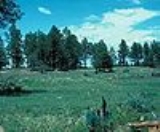
Point of Pines Sites
Encyclopedia
Point of Pines Sites is a set of archaeological
sites in the U.S. state
of Arizona
that are significant for associations with Anasazi, Mogollon and Hohokam
cultures. The sites were chosen as a field school location by Dr. Emil Haury
because of the unusual presence of all three major prehistoric cultures of Arizona.
Point of Pines, actually a series of pueblo sites on a spur off the Nantack Ridge, was also a good location for continuing research that had begun at Kinishba
and Forestdale. For most of its early history the sites in the area fit the model of the Mogollon Culture identified by Haury and others. Later on, after the 13th century there was apparently an influx of Anasazi from the Colorado Plateau
and possibly the Hohokam of the Safford
region.
The presence of Jeddito ware, a pottery type associated with the Hopi
heartland, indicates at least trade with that area if not actual movement of people. Terah Smiley, a student of Haury's at Point of Pines, excavated and identified the rectangular Western Pueblo style kiva
, forms of which are still in use today, at several of the sites.
It was declared a National Historic Landmark
in 1964.
Archaeology
Archaeology, or archeology , is the study of human society, primarily through the recovery and analysis of the material culture and environmental data that they have left behind, which includes artifacts, architecture, biofacts and cultural landscapes...
sites in the U.S. state
U.S. state
A U.S. state is any one of the 50 federated states of the United States of America that share sovereignty with the federal government. Because of this shared sovereignty, an American is a citizen both of the federal entity and of his or her state of domicile. Four states use the official title of...
of Arizona
Arizona
Arizona ; is a state located in the southwestern region of the United States. It is also part of the western United States and the mountain west. The capital and largest city is Phoenix...
that are significant for associations with Anasazi, Mogollon and Hohokam
Hohokam
Hohokam is one of the four major prehistoric archaeological Oasisamerica traditions of what is now the American Southwest. Many local residents put the accent on the first syllable . Variant spellings in current, official usage include Hobokam, Huhugam and Huhukam...
cultures. The sites were chosen as a field school location by Dr. Emil Haury
Emil Haury
Emil Walter "Doc" Haury was an influential archaeologist who specialized in the archaeology of the American Southwest....
because of the unusual presence of all three major prehistoric cultures of Arizona.
Point of Pines, actually a series of pueblo sites on a spur off the Nantack Ridge, was also a good location for continuing research that had begun at Kinishba
Kinishba Ruins
Kinishba Ruins is a sprawling, 600-room great house archaeological site in eastern Arizona and is administered by the Southern Athabaskan-speaking White Mountain Apache Tribe of the nearby Fort Apache Indian Reservation...
and Forestdale. For most of its early history the sites in the area fit the model of the Mogollon Culture identified by Haury and others. Later on, after the 13th century there was apparently an influx of Anasazi from the Colorado Plateau
Colorado Plateau
The Colorado Plateau, also called the Colorado Plateau Province, is a physiographic region of the Intermontane Plateaus, roughly centered on the Four Corners region of the southwestern United States. The province covers an area of 337,000 km2 within western Colorado, northwestern New Mexico,...
and possibly the Hohokam of the Safford
Safford, Arizona
- History :Safford was founded by Joshua Eaton Bailey, Hiram Kennedy and Edward Tuttle, who came from Gila Bend, in southwestern Arizona. They left Gila Bend in the winter of 1873-74; their work on canals and dams having been destroyed by high water the previous summer...
region.
The presence of Jeddito ware, a pottery type associated with the Hopi
Hopi
The Hopi are a federally recognized tribe of indigenous Native American people, who primarily live on the Hopi Reservation in northeastern Arizona. The Hopi area according to the 2000 census has a population of 6,946 people. Their Hopi language is one of the 30 of the Uto-Aztecan language...
heartland, indicates at least trade with that area if not actual movement of people. Terah Smiley, a student of Haury's at Point of Pines, excavated and identified the rectangular Western Pueblo style kiva
Kiva
A kiva is a room used by modern Puebloans for religious rituals, many of them associated with the kachina belief system. Among the modern Hopi and most other Pueblo peoples, kivas are square-walled and underground, and are used for spiritual ceremonies....
, forms of which are still in use today, at several of the sites.
It was declared a National Historic Landmark
National Historic Landmark
A National Historic Landmark is a building, site, structure, object, or district, that is officially recognized by the United States government for its historical significance...
in 1964.
External links
- McDonald Patterned Corrugated Bowl, collected by Emil HauryEmil HauryEmil Walter "Doc" Haury was an influential archaeologist who specialized in the archaeology of the American Southwest....
at Point of Pines in 1952.

